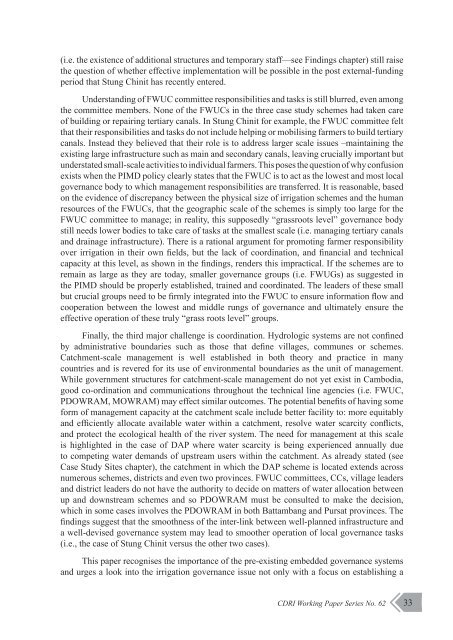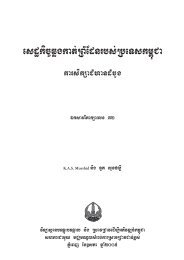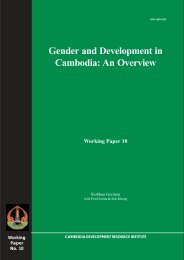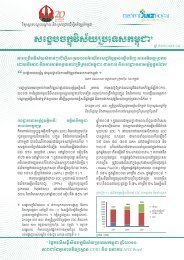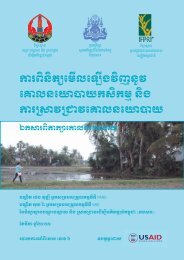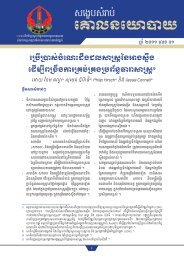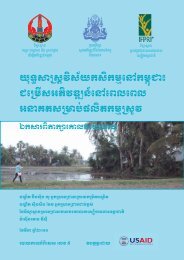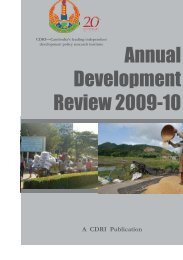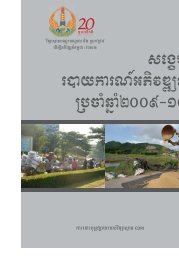62) decentralised governance of irrigation water in cambodia - CDRI
62) decentralised governance of irrigation water in cambodia - CDRI
62) decentralised governance of irrigation water in cambodia - CDRI
You also want an ePaper? Increase the reach of your titles
YUMPU automatically turns print PDFs into web optimized ePapers that Google loves.
(i.e. the existence <strong>of</strong> additional structures and temporary staff—see F<strong>in</strong>d<strong>in</strong>gs chapter) still raise<br />
the question <strong>of</strong> whether effective implementation will be possible <strong>in</strong> the post external-fund<strong>in</strong>g<br />
period that Stung Ch<strong>in</strong>it has recently entered.<br />
Understand<strong>in</strong>g <strong>of</strong> FWUC committee responsibilities and tasks is still blurred, even among<br />
the committee members. None <strong>of</strong> the FWUCs <strong>in</strong> the three case study schemes had taken care<br />
<strong>of</strong> build<strong>in</strong>g or repair<strong>in</strong>g tertiary canals. In Stung Ch<strong>in</strong>it for example, the FWUC committee felt<br />
that their responsibilities and tasks do not <strong>in</strong>clude help<strong>in</strong>g or mobilis<strong>in</strong>g farmers to build tertiary<br />
canals. Instead they believed that their role is to address larger scale issues –ma<strong>in</strong>ta<strong>in</strong><strong>in</strong>g the<br />
exist<strong>in</strong>g large <strong>in</strong>frastructure such as ma<strong>in</strong> and secondary canals, leav<strong>in</strong>g crucially important but<br />
understated small-scale activities to <strong>in</strong>dividual farmers. This poses the question <strong>of</strong> why confusion<br />
exists when the PIMD policy clearly states that the FWUC is to act as the lowest and most local<br />
<strong>governance</strong> body to which management responsibilities are transferred. It is reasonable, based<br />
on the evidence <strong>of</strong> discrepancy between the physical size <strong>of</strong> <strong>irrigation</strong> schemes and the human<br />
resources <strong>of</strong> the FWUCs, that the geographic scale <strong>of</strong> the schemes is simply too large for the<br />
FWUC committee to manage; <strong>in</strong> reality, this supposedly “grassroots level” <strong>governance</strong> body<br />
still needs lower bodies to take care <strong>of</strong> tasks at the smallest scale (i.e. manag<strong>in</strong>g tertiary canals<br />
and dra<strong>in</strong>age <strong>in</strong>frastructure). There is a rational argument for promot<strong>in</strong>g farmer responsibility<br />
over <strong>irrigation</strong> <strong>in</strong> their own fields, but the lack <strong>of</strong> coord<strong>in</strong>ation, and f<strong>in</strong>ancial and technical<br />
capacity at this level, as shown <strong>in</strong> the f<strong>in</strong>d<strong>in</strong>gs, renders this impractical. If the schemes are to<br />
rema<strong>in</strong> as large as they are today, smaller <strong>governance</strong> groups (i.e. FWUGs) as suggested <strong>in</strong><br />
the PIMD should be properly established, tra<strong>in</strong>ed and coord<strong>in</strong>ated. The leaders <strong>of</strong> these small<br />
but crucial groups need to be firmly <strong>in</strong>tegrated <strong>in</strong>to the FWUC to ensure <strong>in</strong>formation flow and<br />
cooperation between the lowest and middle rungs <strong>of</strong> <strong>governance</strong> and ultimately ensure the<br />
effective operation <strong>of</strong> these truly “grass roots level” groups.<br />
F<strong>in</strong>ally, the third major challenge is coord<strong>in</strong>ation. Hydrologic systems are not conf<strong>in</strong>ed<br />
by adm<strong>in</strong>istrative boundaries such as those that def<strong>in</strong>e villages, communes or schemes.<br />
Catchment-scale management is well established <strong>in</strong> both theory and practice <strong>in</strong> many<br />
countries and is revered for its use <strong>of</strong> environmental boundaries as the unit <strong>of</strong> management.<br />
While government structures for catchment-scale management do not yet exist <strong>in</strong> Cambodia,<br />
good co-ord<strong>in</strong>ation and communications throughout the technical l<strong>in</strong>e agencies (i.e. FWUC,<br />
PDOWRAM, MOWRAM) may effect similar outcomes. The potential benefits <strong>of</strong> hav<strong>in</strong>g some<br />
form <strong>of</strong> management capacity at the catchment scale <strong>in</strong>clude better facility to: more equitably<br />
and efficiently allocate available <strong>water</strong> with<strong>in</strong> a catchment, resolve <strong>water</strong> scarcity conflicts,<br />
and protect the ecological health <strong>of</strong> the river system. The need for management at this scale<br />
is highlighted <strong>in</strong> the case <strong>of</strong> DAP where <strong>water</strong> scarcity is be<strong>in</strong>g experienced annually due<br />
to compet<strong>in</strong>g <strong>water</strong> demands <strong>of</strong> upstream users with<strong>in</strong> the catchment. As already stated (see<br />
Case Study Sites chapter), the catchment <strong>in</strong> which the DAP scheme is located extends across<br />
numerous schemes, districts and even two prov<strong>in</strong>ces. FWUC committees, CCs, village leaders<br />
and district leaders do not have the authority to decide on matters <strong>of</strong> <strong>water</strong> allocation between<br />
up and downstream schemes and so PDOWRAM must be consulted to make the decision,<br />
which <strong>in</strong> some cases <strong>in</strong>volves the PDOWRAM <strong>in</strong> both Battambang and Pursat prov<strong>in</strong>ces. The<br />
f<strong>in</strong>d<strong>in</strong>gs suggest that the smoothness <strong>of</strong> the <strong>in</strong>ter-l<strong>in</strong>k between well-planned <strong>in</strong>frastructure and<br />
a well-devised <strong>governance</strong> system may lead to smoother operation <strong>of</strong> local <strong>governance</strong> tasks<br />
(i.e., the case <strong>of</strong> Stung Ch<strong>in</strong>it versus the other two cases).<br />
This paper recognises the importance <strong>of</strong> the pre-exist<strong>in</strong>g embedded <strong>governance</strong> systems<br />
and urges a look <strong>in</strong>to the <strong>irrigation</strong> <strong>governance</strong> issue not only with a focus on establish<strong>in</strong>g a<br />
<strong>CDRI</strong> Work<strong>in</strong>g Paper Series No. <strong>62</strong><br />
33


